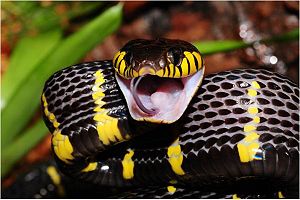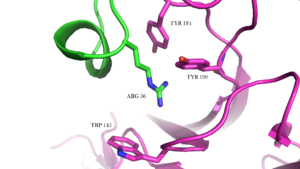Sandbox Reserved 932
From Proteopedia
| Line 39: | Line 39: | ||
=== Denmotoxin interacts with acetylcholine-receptors === | === Denmotoxin interacts with acetylcholine-receptors === | ||
| + | |||
| + | [[Image:Bungarotoxin interaction with nACHr figure text.png|300px|right|thumb| Binding pocket of nAChR with a-bungarotoxin]] | ||
Biochemistry of denmotoxin is unique for its taxon specificity to bird nicotinic acetylcholine receptors (nAChR). Binding of denmotoxin to chick muscle AChR (a1ByS) is a highly irreversible whereas interaction with identical subunit assembly in mouse AChR is reversible. The reversible binding allows the receptor to function properly, but in the case of irreversible binding nAChR is prevented of natural agonist activation. Previous studies with 3FTXs have shown that the binding of toxin leads to “locking down” of the nACh receptor, preventing required conformational change for ion channel activation and induction of signal. | Biochemistry of denmotoxin is unique for its taxon specificity to bird nicotinic acetylcholine receptors (nAChR). Binding of denmotoxin to chick muscle AChR (a1ByS) is a highly irreversible whereas interaction with identical subunit assembly in mouse AChR is reversible. The reversible binding allows the receptor to function properly, but in the case of irreversible binding nAChR is prevented of natural agonist activation. Previous studies with 3FTXs have shown that the binding of toxin leads to “locking down” of the nACh receptor, preventing required conformational change for ion channel activation and induction of signal. | ||
Revision as of 13:35, 15 May 2014
| This Sandbox is Reserved from 01/04/2014, through 30/06/2014 for use in the course "510042. Protein structure, function and folding" taught by Prof Adrian Goldman, Tommi Kajander, Taru Meri, Konstantin Kogan and Juho Kellosalo at the University of Helsinki. This reservation includes Sandbox Reserved 923 through Sandbox Reserved 947. |
To get started:
More help: Help:Editing |
B. Dendrophila monomeric toxin (Denmotoxin) is the primary protein of snake venom used by Boiga dendrophila. This colubrid snake lives in Southest Asian lowland rainforest and mangrove swamps using birds as its primary prey.
One of the most well characterized snake venom protein families is the Three-finger-toxins (3FTX). These proteins consist of three β-stranded finger-like polypeptide loops stabilized by four disulphide bridges on the surface of a globular core. In non-convential 3TFXs a fifth disulphide bridge can be present as is the case in Denmotoxin.
Denmotoxin functions by binding to Muscle Acetylcholine receptors (AChR). The toxin shows high bird-specific neurotoxicity.
Denmotoxin
| |||||||||||
Additional Information
References
Pawlak, J.; Mackessy, S.; Fry, B.; Bhatia, M.; Mourier, G.; Fruchart-Gaillard, C.; Servent, D.; Ménez, R.; Stura, E.; Ménez, A. 2006. Denmotoxin, a Three-finger Toxin from the Colubrid Snake Boiga dendrophila (Mangrove Catsnake) with Bird-specific Activity. The Journal of Biological Chemistry: 281: 29030-29041 doi: 10.1074/jbc.M605850200

![Three fingers formed by three peptide loops (F1, F2 & F3) [PDB=2H5F]](/wiki/images/thumb/3/3f/Kolme_sormea_figure_text.png/300px-Kolme_sormea_figure_text.png)

